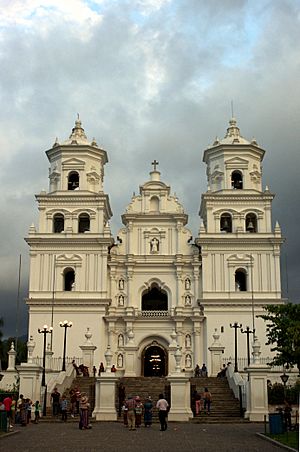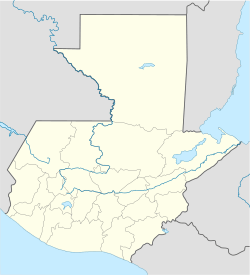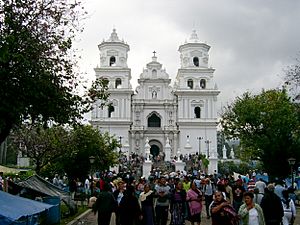Esquipulas facts for kids
Quick facts for kids
Esquipulas
|
||
|---|---|---|
|
Municipality and town
|
||

Basilica of Esquipulas
|
||
|
||
| Country | ||
| Department | ||
| Area | ||
| • Total | 191 sq mi (495 km2) | |
| Population
(2018 census)
|
||
| • Total | 53,556 | |
| • Density | 280.22/sq mi (108.19/km2) | |
| Climate | Aw | |
Esquipulas is a town and municipality in eastern Guatemala. Its original name was Yzquipulas, and it's also known as Isquitzuchil, meaning "place where flowers abound" in Nahuatl.
Esquipulas is famous for the beautiful Black Christ. This important statue is located in the Basilica of Esquipulas. Because of the Black Christ, the town is a very important place for Catholic pilgrims from all over Central America. It's one of the most visited towns in Guatemala, after Guatemala City.
In 2002, UNESCO considered adding Esquipulas to its list of World Heritage sites. The town is visited by about four to five million tourists and religious people every year. Even Pope John Paul II visited in 1996, calling Esquipulas the "Capital Central to the Faith." Teresa of Calcutta also visited this special town.
Esquipulas was also where the important Esquipulas Peace Accords were signed in the mid-1980s. In 1987, the Trifinio Biosphere Reserve was created nearby to protect the unique plants and animals in the area.
The municipality covers an area of 495 square kilometers. It has 20 villages and 123 smaller settlements. In 2018, the total population was 53,556 people. The town of Esquipulas itself had 18,667 residents. Esquipulas is located 222 kilometers from Guatemala City. It's also very close to the borders of Honduras and El Salvador.
Contents
Exploring Esquipulas: A Special Town
A Look Back in Time: History
Ancient People of Esquipulas
The northern part of Esquipulas was once home to the Ch'orti' people. They were descendants of the ancient Maya people from Copán, Honduras. The Chorti culture grew here for many years. Even after the Spanish arrived, some Chorti people stayed, though many moved to other areas.
Another group that lived here was the Payaqui people. Their history is connected to the ancient Maya culture, with the name Isquitzuchil appearing as early as 1000 BC.
Spanish Arrival and Conquest
In 1524, Spanish forces first came to the area that is now Guatemala. By 1525, they reached the region where the Chorti people lived. The Spanish wanted to take control and introduce the Catholic religion.
In 1525, Spanish captains working for Pedro de Alvarado conquered the Chiquimula province. This led to the Catholic religion being brought to the local people. In 1530, the local leaders tried to fight back against the Spanish. After three days of fighting, the people of the region decided to surrender for peace.
Founding of Esquipulas
Between 1550 and 1560, the town of Yzquipulas, which later became Esquipulas, was founded by Juan Pérez Dardón. He brought Mayan-Chortí and Mayan-Payaquí slaves from other parts of the region. The town was planned with a main street and two city plazas.
By the early 1700s, Esquipulas was a growing Spanish community. Its population increased a lot over the next century. Many settlers were drawn to the area because its valleys were very fertile, meaning good for farming.
The Heart of Faith: Catholicism in Esquipulas
In 1594, the people of Esquipulas asked a sculptor named Quirio Cataño to create a statue of a crucified Christ with a dark complexion. This statue, known as the Black Christ, was delivered on October 4, 1594. It arrived in Esquipulas on March 9, 1595, and was first placed in a small chapel. People quickly began to call the sculpture "miraculous."
By 1650, Esquipulas had become a very important Catholic site. People from other provinces came to visit. In 1680, construction began on the Santiago Church, which was finished in 1682. The Black Christ statue was then moved there.
In 1740, the bishop of Guatemala, Fray Pedro Pardo de Figueroa, wanted a larger church built. He wanted to thank the Black Christ for healing him from an illness. He hired architect Felipe José de Porres to build a grand basilica.
Fray Pedro Pardo de Figueroa passed away in 1751 and was buried in the basilica. The construction continued under a new bishop and was finished in late 1758. The new basilica was officially opened on January 4, 1759. The famous Black Christ statue was moved into its new home on January 6, 1759.
Learning in Esquipulas: Education
| Village | Surface Square km |
Hamlets |
|---|---|---|
| City of Esquipulas hamlets | There are four hamlets within the city and, even though they are not outside city limits, there are considerably far away from downtown:
El Ciracil, El Sillón, Tizaquín and Vuelta Grande |
|
| Atulapa | 37 | Agua Caliente, Amatal, Agua Zarca, Bojorquez, Canoas, El Barrial, El Cerrón, Horno de Vides, La Brea, La Casona, Mesa Grande, Montesinas and Zompopero |
| Santa Rosalía | 31 | El Duraznal, El Jocotal, El Limón, La Cuestona, Las Toreras, El Portezuelo and Plan de La Arada |
| San Nicolás | 32 | El Barrial, El Cascajal, Chaguitón, Guayabito, Miramundo and Tecomapa |
| La Granadilla | 40 | El Chuctal, El Olvido, El Porvenir and Floripundio |
| Olopita | 46 | Cuevitas, El Bueyero, Las Crucitas, Olopita Centro, Piedra Redonda, San Cristóbal, San Juan and Tontoles |
| Valle Dolores | 33 | El Chaguite, El Chorro, Los Vados, San Juan Arriba and Tierra Colorada |
| Belén (El Tablón) | 10 | Agua Zarca, Chiramay, El Zapote and La Ruda |
| Cruz Alta | 27 | Curruche and Las Palmas |
| Jagua (Las Cañas) | 37 | El Empedrado, El Encino, El Jicaro, El Peñasco (Death plane), El Pinalito, El Salitre, La Cumbre, Las Sopas, Lagunas, Llano de Guerra, Ojo de Agua, Palmitas, Rincón de María, San Francisco Buena Vista and Tareas |
| Las Peñas | 30 | El Incienso, El Palmar, El Pesote, Joyas Verdes, La Fortuna, Miramundo and Queseras |
| El Zarzal | 19 | El Guineal, Malcotal, Potrerillos, Zapotal and Zapotalito |
| Valle de Jesús | 6 | Valle de Jesús |
| San Isidro | 10 | Capucal, El Chuctal, Entre Ríos and Malcotalito |
| Chanmagua | 30 | El Pedregal, Las Pozas, Los Varales and Laguna Seca |
| Cafetales | 20 | La Aradona, La Rinconada, Loma Alta and Llano Largo |
| El Carrizal | 25 | Bailadero, Joyitas, Llano de los Toros, Pericos and Tabloncito |
| Horcones | 15 | Calzontes, El Zarzalito, Piedra de Amolar, Tablón de Gámez and Tishac |
| Timushán | 40 | Cañada del Pino, El Mojón, El Bajío, Loma del Mango, Los Fierros, Llano de San Gaspar, Malcinca, Pasaljá, San Antonio Sulay, San Miguel Mapa, Suyate and Tablón de Sulay |
| Monteros | 10 | El Horno and El Rincón de León |
| Carboneras | 10 | El Rincón |
|
|
||
A large part of Esquipulas' population, about 52%, is made up of young people aged 0 to 25. A big portion of these young people, about 64%, are students. Esquipulas has a high quality of education, considered the best in eastern Guatemala.
The school year in Esquipulas usually lasts 180 days, from January to October. Many students, about 70%, attend private schools. The remaining 30% go to public government schools.
Esquipulas is known for its youth participating in the National Science Olympiad in Guatemala. This event is organized by the University of San Carlos de Guatemala. Young people from Esquipulas have won many gold, silver, and bronze medals in various subjects.
Science Olympiad Winners
Esquipulas has the most winners and awards in the National Science Olympiad (ONC). Students compete in subjects like mathematics, natural sciences, social sciences, chemistry, physics, and biology. They participate at different levels, from basic to advanced.
Visiting Esquipulas: Tourism
Because Esquipulas is such an important religious and tourist center, many people in the town work in tourism. There's also a strong coffee industry here, producing some of Guatemala's best coffee. Religious tourism is especially popular, with many pilgrims visiting the Black Christ statue.
Tourism in Esquipulas has grown steadily. People are attracted to its natural beauty, colonial history, and unique culture. Visitors especially enjoy the religious colonial sites, like the Basilica of Esquipulas.
Some interesting places to visit in Esquipulas are:
- Basilica of Esquipulas
- "Los Compadres" stone
- Mine cave
- Trifinio Biosphere Reserve
- Chatún Park
- "El Guisayote" biosphere reserve
- Acueducto "Los Arcos"
- Río Atulapa
The Grand Basilica of Esquipulas
In 1956, Pope Pius XII made the area around the Black Christ statue a special religious territory. He also named the Santuario de Esquipulas Cathedral as its main church. The Archbishop of Guatemala, Monsignor Mariano Rossell y Arellano, was put in charge. He asked the Benedictine Abbey of San José from the USA to help care for the sanctuary. Three monks arrived in 1959 to start the Benedictine Monastery of Esquipulas, which still looks after the Basilica today.
In 1961, Pope John XXIII officially gave the Esquipulas shrine the special title of "Minor Basilica." This makes it the only basilica in Central America.
The Mysterious "Los Compadres" Stone
"Los Compadres" are two large stones, one balanced strangely on top of the other. They have survived many years and earthquakes. The top stone is about the size of a car, and together they are about three meters tall. They weigh around 50 tons! Local communities believe these stones show divine power. People visit the site for sacred rituals, prayers, and offerings.
The Mine Cave
Local stories say that the famous sculptor Quirio Catano, who created the Black Christ, found inspiration for the statue in this cave.
The Mine Caves are located south of the city, near the Basilica. People say that a silver mine was found here long ago. The money from this mine supposedly helped pay for the Basilica's construction.
Many indigenous pilgrims visit these caves. They believe the caves are connected to the miraculous Black Christ of Esquipulas. They perform their own rituals, burning candles and leaving offerings. The caves are on private land, and the owner has created the "Cuevas de las Minas" Ecological Park. This park has a zoo with over 25 animal species and modern facilities for visitors.
Chatún Park: Adventure and Nature
Chatún is an Adventure and Fun Park. It's designed to show off the area's diverse natural resources, customs, and traditions. The park focuses on adventure and nature activities.
Farming in Esquipulas: Agriculture
Esquipulas is also known for its agriculture, especially coffee. The coffee from Esquipulas, called Sertamenes Esquipulas, has won many national and international awards. It's known as some of the best and richest coffee from Guatemala. Three farms in the area, Finca Cloud and Finca Cascajal, have won contests for "The Best Coffee in Guatemala and the World."
Faith and Culture
The Basilica: A Spiritual Center
The cathedral in Esquipulas was named a basilica in 1961 by Pope John XXIII. In 1995, to celebrate 400 years of the shrine, Pope John Paul II called it "the spiritual center of Central America."
Every year, thousands of pilgrims travel from Guatemala, the United States, Mexico, Europe, and other Central American countries. They come to honor the dark wooden statue of the crucified Christ. This is the most respected Catholic shrine in the region.
There's also a strong connection between Esquipulas and El Santuario de Chimayo, a major Catholic pilgrimage site in Chimayó, United States.
Holy Earth Tablets
Esquipulas is famous for its Tierra Santa (Holy Earth) clay tablets. Pilgrims buy these tablets during church festivals. The clay comes from local deposits and is cleaned and pressed into small cakes. This clay is also called tierra bendita (blessed earth) or Tierra del Santo (earth of the saint).
These medicinal clay tablets are popular all over Central America, known by many names like akipula or cipula. Some pilgrims eat the clay, believing it can cure illnesses, while others rub it on themselves. Similar traditions exist at the sister shrine of El Santuario de Chimayo in the US.
Beauty and Celebrations
The biggest beauty event in Esquipulas is "Miss Beauty of Esquipulas." This used to be called "Señorita Esquipulas." Another important event is the National Queen of the Independence Party. These contests are considered the second most important beauty pageants in Guatemala, after "Miss Universe Guatemala."
Notable People from Esquipulas
- Marco Tulio Rivas: A soccer player who played for the Guatemala SUB-20 team in the 2011 World SUB-20 tournament in Colombia.
- Juan Pablo Espino: A Guatemalan writer recognized nationally for his work.
- Mario Salazar Grande: An artist and painter known internationally for his paintings.
- Milagro Acevedo: An educator with international experience in the Montessori method.
- Hania Hernández: A beauty queen who has won many national and international contests.
Weather in Esquipulas
| Climate data for Esquipulas | |||||||||||||
|---|---|---|---|---|---|---|---|---|---|---|---|---|---|
| Month | Jan | Feb | Mar | Apr | May | Jun | Jul | Aug | Sep | Oct | Nov | Dec | Year |
| Mean daily maximum °C (°F) | 27 (81) |
29 (84) |
30 (86) |
33 (91) |
31 (88) |
30 (86) |
29 (84) |
28 (82) |
29 (84) |
26 (79) |
28 (82) |
28 (82) |
28 (82) |
| Mean daily minimum °C (°F) | 10 (50) |
9 (48) |
10 (50) |
10 (50) |
10 (50) |
11 (52) |
11 (52) |
13 (55) |
13 (55) |
11 (52) |
8 (46) |
9 (48) |
8 (46) |
| Average precipitation mm (inches) | 2.0 (0.08) |
1.1 (0.04) |
11.7 (0.46) |
50.9 (2.00) |
141.9 (5.59) |
211.8 (8.34) |
415.1 (16.34) |
278.3 (10.96) |
220.2 (8.67) |
654.9 (25.78) |
32.0 (1.26) |
2.9 (0.11) |
1,533.4 (60.37) |
See also
 In Spanish: Esquipulas para niños
In Spanish: Esquipulas para niños





